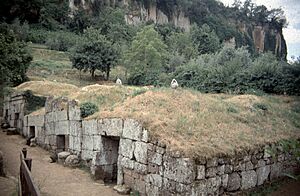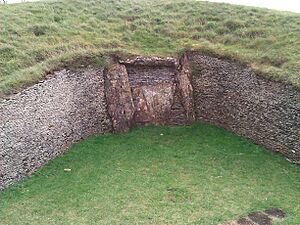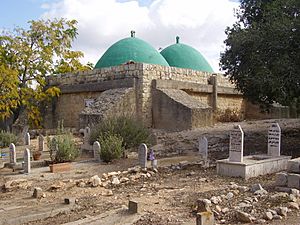Womb tomb facts for kids
The term Womb Tomb describes a special kind of ancient burial site from the Neolithic Age. This was a time long ago when people started farming. These tombs were often built to look like a mother's womb, symbolizing a return to the earth or the idea of new life. The term also describes some newer burial sites that are visited by Christian and Muslim pilgrims.
The idea of returning to the earth is very old. Many ancient beliefs, including those in the Bible, talk about people coming from the earth and returning to it after death. For example, the Bible says, "from dust you came and to dust you will return." This idea connects to the "womb tomb" concept, where the burial place represents a return to a nurturing, life-giving source.
In Scotland and Ireland, many of these ancient burial sites are found. They show how important birth and the female form were to people long ago. These special tombs are a type of passage grave, which means they have a long passage leading to a central burial chamber.
Contents
Evidence of Womb Tombs
Ancient Burial Sites
Scotland has many well-preserved chambered burial tombs, similar to Ireland. Experts who study these sites, like archaeologists, have found that many of them follow a similar design. They often have a main chamber, a passage leading to it, and an entrance. This design is thought to represent parts of the female body, symbolizing a return to the mother or the earth.
Writers like William Shakespeare and D. H. Lawrence have also explored this idea in their works. They wrote about the ancient belief that death was a return to the mother or a source of life. For example, D. H. Lawrence visited old tombs in Italy and felt they showed the mystery of life and death.
Modern Pilgrimage Sites
The name "womb tomb" has also been used for more recent burial sites, especially those visited by pilgrims. Researchers Stadler and Luz studied Christian and Muslim pilgrimage sites, like the tomb of St. Mary in Jerusalem and Maqam Abu al-Hijja in Galilee. They noticed that the design of these tombs also seemed to mimic the human form.
Their studies suggest that the way these sites are built and worshipped shows how important the idea of new life and continuity is to both Christian and Muslim communities.
Scottish Archaeological Findings
In Britain, ancient passage graves in the west and north are different from other types of burial mounds found in the east. Passage graves usually have round mounds and are found along the Atlantic coast, from Spain all the way to the Orkney Islands in Scotland.
Audrey Henshall, a researcher who studied tombs across Scotland, found features like special entrances and shapes that support the "womb tomb" idea. She believes that burial ceremonies took place both inside and outside these tombs. These rituals often focused on ideas of new life and the continuation of generations.
In Scotland, the term "womb tomb" usually refers to these chambered burial mounds. It describes the general shape and meaning of the tomb, rather than a specific way of burying people. It is also used for certain pilgrimage sites for both Christian and Muslim visitors.
Womb Tombs and Holy Sites
Recent research by Stadler & Nurit (2014) looked at how the term "womb-tomb" applies to modern religious buildings. They found that religious buildings often use shapes and designs that represent parts of the human body or society. Caves, for example, have often been seen as womb-like places. They were used for religious ceremonies long before people started living in them.
This idea is similar across different religions. For example, in ancient Mesoamerican beliefs (like the Maya and Aztec), the Earth was often seen as a female figure. Because of this, caves were strongly connected to the Mother Earth and goddesses of new life.
See also
- Belas Knap
- Court cairn
- Chamber tomb
- Kaukab Abu al-Hija




